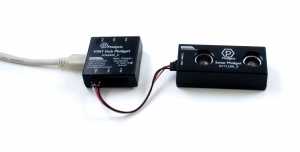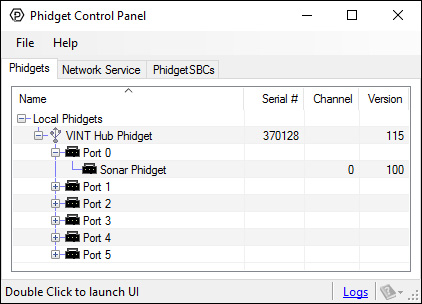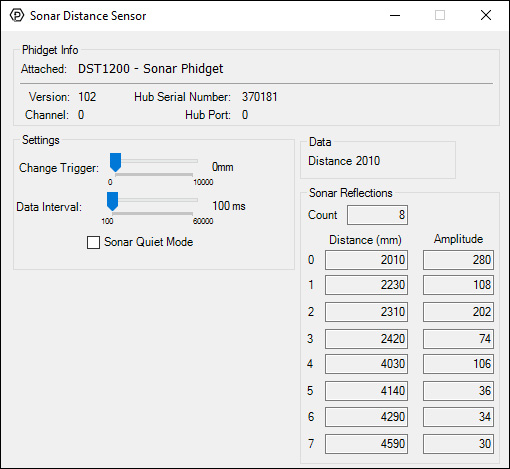DST1200 User Guide: Difference between revisions
No edit summary |
|||
| Line 6: | Line 6: | ||
* An DST1200 Sonar Phidget | * An DST1200 Sonar Phidget | ||
* A {{VINTHub}} | * A {{VINTHub}} | ||
* A 3-wire | * A 3-wire Phidget cable | ||
* A USB cable | * A USB cable | ||
* A computer | * A computer | ||
| Line 12: | Line 12: | ||
===Connecting the Pieces=== | ===Connecting the Pieces=== | ||
# Connect the DST1200 to the VINT Hub using the | # Connect the DST1200 to the VINT Hub using the Phidget cable. | ||
# Connect the VINT Hub to your computer with a USB cable. | # Connect the VINT Hub to your computer with a USB cable. | ||
Revision as of 16:54, 2 May 2017

Required Hardware
- An DST1200 Sonar Phidget
- A VINT Hub
- A 3-wire Phidget cable
- A USB cable
- A computer
Connecting the Pieces
- Connect the DST1200 to the VINT Hub using the Phidget cable.
- Connect the VINT Hub to your computer with a USB cable.
Testing Using Windows
Phidget Control Panel
In order to demonstrate the functionality of the DST1200, the Phidget Control Panel running on a Windows machine will be used.
The Phidget Control Panel is available for use on both macOS and Windows machines.
Windows
To open the Phidget Control Panel on Windows, find the ![]() icon in the taskbar. If it is not there, open up the start menu and search for Phidget Control Panel
icon in the taskbar. If it is not there, open up the start menu and search for Phidget Control Panel
macOS
To open the Phidget Control Panel on macOS, open Finder and navigate to the Phidget Control Panel in the Applications list. Double click on the ![]() icon to bring up the Phidget Control Panel.
icon to bring up the Phidget Control Panel.
For more information, take a look at the getting started guide for your operating system:
Linux users can follow the getting started with Linux guide and continue reading here for more information about the DST1200.
First Look
After plugging the DST1200 into your computer and opening the Phidget Control Panel, you will see something like this:

The Phidget Control Panel will list all connected Phidgets and associated objects, as well as the following information:
- Serial number: allows you to differentiate between similar Phidgets.
- Channel: allows you to differentiate between similar objects on a Phidget.
- Version number: corresponds to the firmware version your Phidget is running. If your Phidget is listed in red, your firmware is out of date. Update the firmware by double-clicking the entry.
The Phidget Control Panel can also be used to test your device. Double-clicking on an object will open an example.
Distance Sensor
Double-click on the Distance Sensor {{{1}}} object in order to run the example:

General information about the selected object will be displayed at the top of the window. You can also experiment with the following functionality:
- Modify the change trigger and/or data interval value by dragging the sliders. For more information on these settings, see the data interval/change trigger page.
- Toggle the Quiet Mode with the checkbox. For more information on Quiet Mode, check out the technical section.
- The distance (mm) of the strongest reflection will be shown in the Data box. All other reflections (distance and amplitude) can be seen in the Sonar Reflections box. These additional reflections can correspond to other objects, or echoes of the primary object.
Testing Using Mac OS X
- Go to the Quick Downloads section on the Mac OS X page.
- Download and run the Phidget OS X Installer
- Click on System Preferences >> Phidgets (under Other) to activate the Preference Pane
- Make sure your device is properly attached
- Double click on your device's objects in the listing to open them. The Preference Pane and examples will function very similarly to the ones described above in the Windows section.
Testing Using Linux
For a general step-by-step guide on getting Phidgets running on Linux, see the Linux page.
Using a Remote OS
We recommend testing your Phidget on a desktop OS before moving on to remote OS. Once you've tested your Phidget, you can go to the PhidgetSBC, or iOS pages to learn how to proceed.
Technical Details
Quiet Mode
The DST1200 has an option for "quiet mode" which, as the name suggests, reduces the volume of the sound pulses used by the sonar sensors. While the sound that this Phidget makes is audible in either mode, it is much more noticeable without quiet mode enabled. By enabling quiet mode, you will affect the maximum sensing range and the number of reflections detected. Quiet mode also consumes less power, as explained in the next section.
Current Consumption
The current consumption of the DST1200 varies depending on the data interval you choose. The longer the interval between samples, the lower the current consumption. Switching to quiet mode also lowers current consumption slightly.

Amplitude Response
When you receive data from the DST1200, you'll end up with an array of sonar reflections that each have a distance and an amplitude. The distance, of course, refers to how far away the object is. The amplitude gives you a general idea of the size of the object. The amplitude value can range from 3 to approximately 900, with 3 being a very small reflection and 900 being a very large one. In most applications, when you're using the DST1200 as an ordinary distance sensor, you'll probably want to ignore all reflections except for the one with the greatest amplitude.
What to do Next
- Programming Languages - Find your preferred programming language here and learn how to write your own code with Phidgets!
- Phidget Programming Basics - Once you have set up Phidgets to work with your programming environment, we recommend you read our page on to learn the fundamentals of programming with Phidgets.
